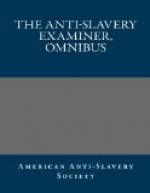Our colored fellow-citizens, like others, are occasionally called to pass from one place to another; and in doing so are compelled to submit to innumerable hardships and indignities. They are frequently denied seats in our stage coaches; and although admitted upon the decks of our steam boats, are almost universally excluded from the cabins. Even women have been forced, in cold weather, to pass the night upon deck, and in one instance the wife of a colored clergyman lost her life in consequence of such an exposure.
The contempt poured upon these people by our laws, our churches, our seminaries, our professions, naturally invokes upon their heads the fierce wrath of vulgar malignity. In order to exhibit the actual condition of this portion of our population, we will here insert some samples of the outrages to which they are subjected, taken from the ordinary public journals.
In an account of the New York riots of 1834, the Commercial Advertiser says—“About twenty poor African (native American) families, have had their all destroyed, and have neither bed, clothing, nor food remaining. Their houses are completely eviscerated, their furniture a wreck, and the ruined and disconsolate tenants of the devoted houses are reduced to the necessity of applying to the corporation for bread.”
The example set in New York was zealously followed in Philadelphia. “Some arrangement, it appears, existed between the mob and the white inhabitants, as the dwelling houses of the latter, contiguous to the residences of the blacks, were illuminated and left undisturbed, while the huts of the negroes were singled out with unerring certainty. The furniture found in these houses was generally broken up and destroyed—beds ripped open and their contents scattered in the streets.... The number of houses assailed was not less than twenty. In one house there was a corpse, which was thrown from the coffin, and in another a dead infant was taken out of the bed, and cast on the floor, the mother being at the same time barbarously treated.”—Philadelphia Gazette.
“No case is reported of an attack having been invited or provoked by the residents of the dwellings assailed or destroyed. The extent of the depredations committed on the three evenings of riot and outrage can only be judged of by the number of houses damaged or destroyed. So far as ascertained, this amounts to FORTY-FIVE. One of the houses assaulted was occupied by an unfortunate cripple—who, unable to fly from the fury of the mob, was so beaten by some of the ruffians, that he has since died in consequence of the bruises and wounds inflicted ... For the last two days the Jersey steam boats have been loaded with numbers of the colored population, who, fearful their lives were not safe in this, determined to seek refuge in another State. On the Jersey side, tents were erected, and the negroes have taken up a temporary residence, until a prospect shall be offered for their perpetual location in some place of security and liberty.”—National Gazette.




